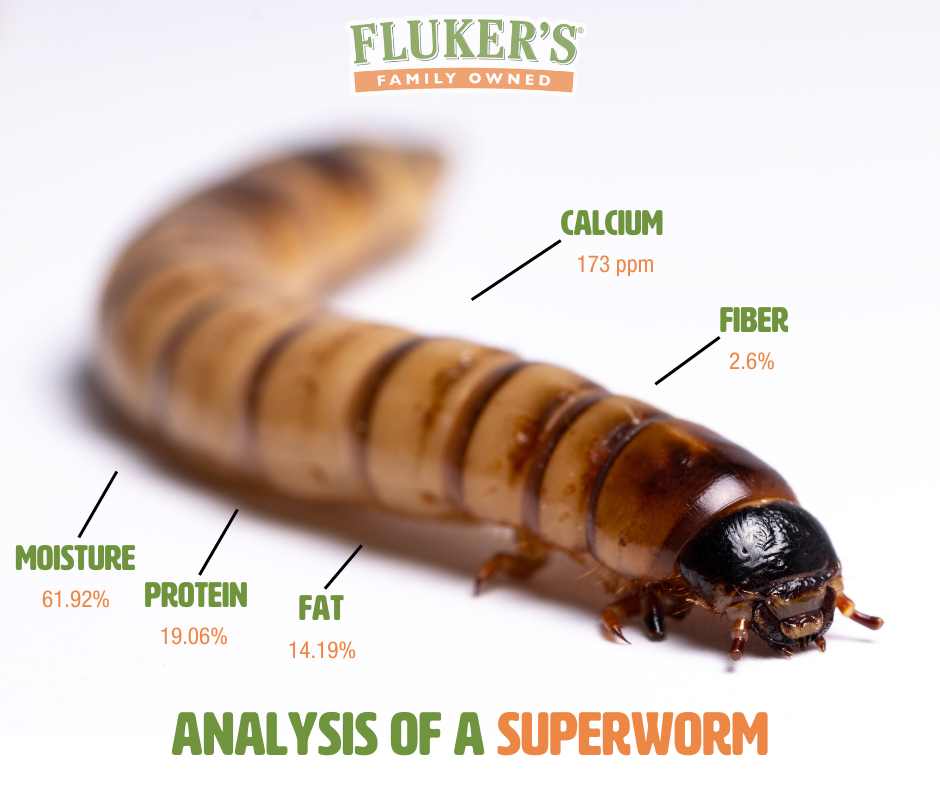The Darkling Beetle Larvae, Better Known as the Superworm
Posted by Erik Neff, Chief Scientific Officer, M.S. Entomologist at Fluker Farms - Research@flukerfarm.com on Apr 5th 2024
A Classic Case of Mistaken Identity
Superworms are one of the most misnamed feeders in the insect world. People mistakenly believe these critters are worms. Superworms (Zophobasmorio) are a type of darkling beetle. Despite their inaccurate name, superworms do have some super qualities.
These insects play a key function in the ecosystem as decomposers and a vital part of the circle of life. They are a nutritious snack and important food for animals like reptiles, birds, fish, and exotic pets such as bearded dragons. Superworms have higher calcium, fat, and fiber levels than crickets and giant mealworms. This makes them a popular choice for pet owners who want to provide their pets with a balanced diet. Additionally, superworms have more chitin in their shell than other feeders such as mealworms, providing higher calcium fiber, and fat.
The chitin in superworms promotes two things:
1. Chitin can act like a fiber due to your pet’s inability to break it down during the digestion process.
2. Chitin can function as an immune booster
Here is an analyzed version of our superworms at Fluker’s:

Analyzing Live Superworm
Moisture 61.92%
Fat 14.19%
Protein 19.06%
Fiber 2.6%
Calcium 173 ppm
Feeder insects have a unique life cycle. Understanding the different feeder insect life cycles can assist you in caring for your pet and deciding what to feed it.
The Beginning of the Life Cycle
The superworm life cycle begins with the female beetle laying eggs. Superworms will lay oviposit eggs into a dry substrate and prefer less humid conditions. They are extremely sensitive to their environment. The optimal temperature for production is between 75-90 degrees.
In the best conditions, eggs turn into small white larvae that get darker with each molt. As the larvae grow, they molt several times.
What is molting?
Molting is the process of shedding an exoskeleton to allow for growth. These molts are necessary for the larvae to reach their full size and eventually pupate. After molting its exoskeleton, the superworm's movement becomes restricted. The process then initiates sclerotization, the act of hardening the cuticle, and melanization, the procedure of darkening the cuticle.
These processes are also a natural defense mechanism against various environmental stressors, including infections or injuries.
What do Superworms Turn Into?
Once the larvae reach a certain size, they enter the pupal stage and require individual separation to pupate. During this stage, the larvae metamorphose transforming the larvae into adult beetles.
The time it takes for an egg to become an adult insect can vary from a few months to half a year. This variation depends on the environment. Once the adult beetles emerge from their cocoons, they are ready to mate and start the cycle over again.
What do Superworms Eat?
Superworms are an important part of the ecosystem. They help break down organic matter and recycle nutrients back into the soil. They are relatively easy to care for, just keep them at room temperature.
Use wheat middling, oatmeal, or Fluker's mealworm bedding to provide both food and bedding for superworms. For hydration, add slices of potato on top of their substrate. They can also live on fruits and vegetables like apples and carrots, which give them the food and water they need to survive.
Superworms process and expel their food after consuming it. Insect poop, called frass, is rich in nutrients like phosphorus, nitrogen, and potassium. These readily available nutrients make frass the perfect fertilizer for your plants.
No Laughing Matter
The Superworms Zophobas Morio black wasting virus (ZmBWV) is impacting the worldwide superworm populations. One can identify the early onset stages of this diseases if you begin to notice the insects will start turning over and darkening.The insects will start turning over and darkening. When they begin to curl up, it's a sign they are beginning to perish.
If your colony is at risk of contamination, it's important to act fast to protect your insects. In these cases, it's best to replace all your insects and superworms with new ones when setting up a new environment. This will prevent any contamination from spreading.
These steps will keep your insect colony healthy and prevent diseases or parasites from spreading. By being proactive, you can protect the health and stability of your colony.
Thankfully, female beetles can lay hundreds of eggs during their lifetime, ensuring a continuous population of superworms. With continued research and due diligence, hopefully, this virus will bug off soon.
In Conclusion
Superworms may not actually be worms, but they are still fascinating creatures to observe. Their life cycle, from egg to larva to pupa to adult beetle, is a marvel of nature's design. These beetles may not be as flashy as butterflies or as majestic as eagles, but they play a crucial role in the ecosystem. They help break down organic matter, enriching the soil and providing food for other animals.
Next time you see giant "worms” at the pet store or online, remember to find the humor in their misleading name. These insects are powerful and impressive. And remember, even if they are not actually worms, they are still super in their own unique way.
In a world full of strange creatures, there is a beetle larva that resembles a worm. This unique creature is just one of the many fascinating aspects of nature. So cheers to the superworms that are not actually worms- may their funny name keep making insect lovers happy all around the world.

